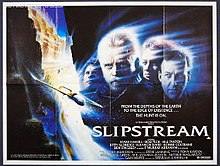
Do Androids Dream of Electric Sheep? is a 1968 dystopian science fiction novel by American writer Philip K. Dick. It is set in a post-apocalyptic San Francisco, where Earth's life has been greatly damaged by a nuclear global war, leaving most animal species endangered or extinct. The main plot follows Rick Deckard, a bounty hunter who has to "retire" six escaped Nexus-6 model androids, while a secondary plot follows John Isidore, a man of sub-par IQ who aids the fugitive androids.
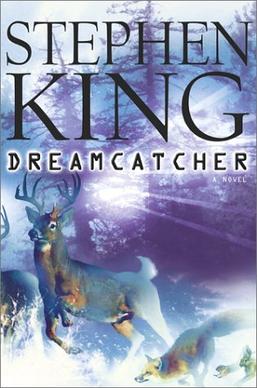
Dreamcatcher is a 2001 science fiction horror novel by American writer Stephen King, featuring elements of body horror, suspense and alien invasion. The book, written in cursive, helped the author recuperate from a 1999 car accident, and was completed in half a year. According to the author in his afterword, the working title was Cancer. His wife, Tabitha King, persuaded him to change the title. A film adaptation was released in 2003.

Wizards is a 1977 American animated post-apocalyptic science fantasy film written, directed and produced by Ralph Bakshi and distributed by 20th Century-Fox. The film follows a battle between two wizards of opposing powers, one representing the forces of magic and the other representing the forces of technology.

The Crow: City of Angels is a 1996 American superhero film directed by Tim Pope from a screenplay by David S. Goyer, and sequel to the 1994 film The Crow in addition to the second installment in The Crow film series. The film stars Vincent Pérez, Mia Kirshner, Richard Brooks, Iggy Pop, Thomas Jane and Thuy Trang.

The Crow: Salvation is a 2000 American superhero film directed by Bharat Nalluri. Starring Eric Mabius as Alex Corvis and the third installment of The Crow film series, based on the comic book character of the same name by James O'Barr. After its distributor cancelled the intended wide theatrical release due to The Crow: City of Angels' negative critical reception, The Crow: Salvation was released direct-to-video after a limited theatrical run.

Brainscan is a 1994 American science fiction slasher film directed by John Flynn and written by Andrew Kevin Walker. The film stars Edward Furlong, Frank Langella, Amy Hargreaves, Jamie Marsh, and T. Ryder Smith. The soundtrack was composed by George S. Clinton.
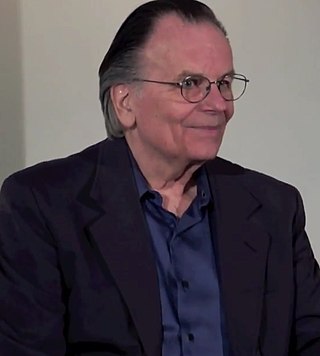
Gary Douglas Kurtz was an American film producer whose list of credits includes American Graffiti (1973), Star Wars (1977), The Empire Strikes Back (1980), The Dark Crystal (1982) and Return to Oz (1985). Kurtz also co-produced the 1989 science fiction adventure film Slipstream, which reunited him with Star Wars star Mark Hamill.

Death Machine is a 1994 science fiction horror film written and directed by Stephen Norrington. It stars Brad Dourif, Ely Pouget, William Hootkins, John Sharian, and Richard Brake. Rachel Weisz, still early in her career at the time of the film's release, appears briefly in the role of a Junior Executive. The film was the directorial debut of Norrington, who had previously worked as a special effects artist on films such as Lifeforce, Aliens, Hardware, The Witches, and Split Second. However, Norrington infamously expressed dissatisfaction with the original cut, and the film has undergone numerous re-edits since.

Solo is a 1996 science fiction action film directed by Norberto Barba, and starring Mario Van Peebles, William Sadler, Adrien Brody, Barry Corbin and Demián Bichir. The film was based on the 1989 novel Weapon by Robert Mason, and was adapted into a screenplay by David L. Corley for Columbia/TriStar Pictures.

Flesh Gordon Meets the Cosmic Cheerleaders is a 1990 Canadian superhero sex comedy film, and the sequel to the sex comedy Flesh Gordon. Like the original, it spoofs the Flash Gordon serials, though the humor is more scatological than the original. Only William Dennis Hunt returns from the original cast.

The Guyver is a 1991 science fiction tokusatsu superhero film directed by Screaming Mad George and Steve Wang, and produced by Brian Yuzna. Loosely based on the Japanese manga series of the same name by Yoshiki Takaya, the film was produced in conjunction with Shochiku Films, the film stars Mark Hamill, Vivian Wu, Jack Armstrong, Jimmie Walker, and David Gale.
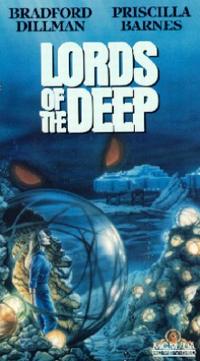
Lords of the Deep is a 1989 American science-fiction horror film co-produced by Roger Corman, about an underwater colony being attacked by alien life forms. Actors included Bradford Dillman and Priscilla Barnes.

Scanners II: The New Order is a 1991 Canadian science fiction thriller film. It is a sequel to the 1981 feature film Scanners with a different cast, starring David Hewlett, Deborah Raffin, Raoul Trujillo, and Yvan Ponton. It was written by B. J. Nelson and directed by Christian Duguay. The plot involves a crooked police commissioner (Ponton) who schemes to gain control of a major city by manipulating Scanners to do his bidding. The film was released direct-to-video.

The Man Who Wasn't There is a 1983 American 3-D comedy film directed by Bruce Malmuth and starring Steve Guttenberg.

Journey to the Center of the Earth is a 1989 fantasy film. It was a nominal sequel to the 1988 film Alien from L.A., both of which are (very) loosely based on the 1864 novel Journey to the Center of the Earth by Jules Verne.

Dark Tower is a 1987 horror film directed by Freddie Francis and starring Michael Moriarty, Jenny Agutter, Theodore Bikel, Carol Lynley, Kevin McCarthy and Anne Lockhart.
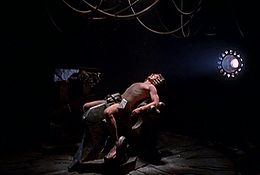
"Without" is the second episode of the eighth season of the science fiction television series The X-Files. The episode first aired in the United States and Canada on November 12, 2000, on Fox and subsequently aired in the United Kingdom on February 18, 2001. It was written by executive producer Chris Carter and directed by Kim Manners. The episode helps to explore the series' overarching mythology and continues from the seventh season finale, "Requiem", and season eight premiere, "Within", in which Fox Mulder was abducted by aliens who are planning to colonize Earth. The episode earned a Nielsen rating of 9.0 in the United States and was seen by 15.1 million viewers. As with the previous episode, "Within," it was generally well-received by critics, although some detractors criticized various plot points.

Starship, also known as Lorca and the Outlaws, and 2084, is a 1984 science fiction film directed by Roger Christian from a screenplay by Christian and Matthew Jacobs, and starring John Tarrant, Deep Roy, Donogh Rees, and Cassandra Webb. The music for the film was written by Tony Banks of Genesis.

Hyper Sapien: People from Another Star is a 1986 Canadian-American science fiction film directed by Peter R. Hunt and starring Dennis Holahan, Ricky Paull Goldin, Sydney Penny, Keenan Wynn, and Rosie Marcel.
The Dark is a 1979 science fiction horror film directed by John Cardos and starring William Devane, Cathy Lee Crosby, Richard Jaeckel, Keenan Wynn, and Casey Kasem.
